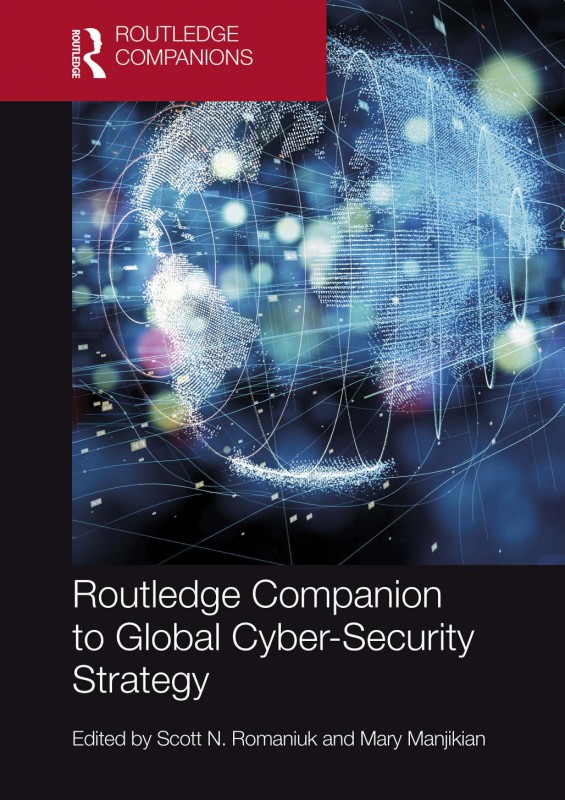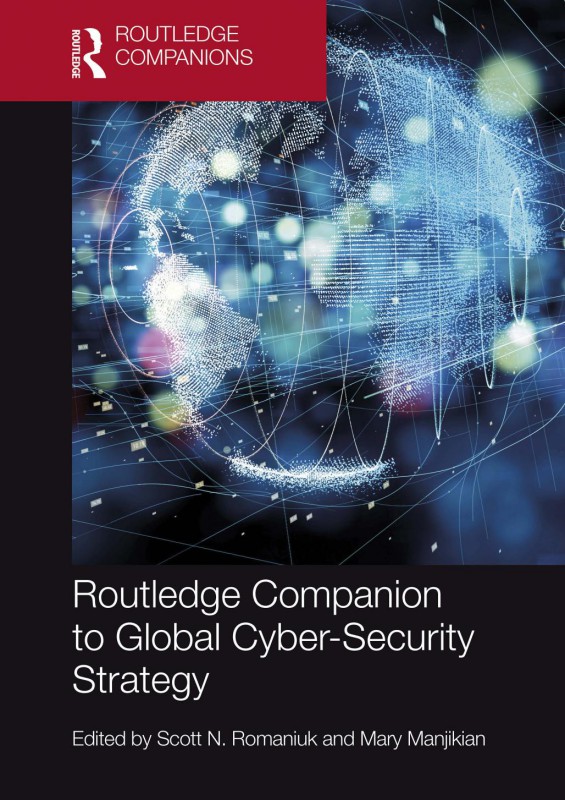Routledge Companion to Global Cyber Security Strategy 1st edition by Scott Romaniuk, Mary Manjikian 0429680368 9780429680366
$50.00 Original price was: $50.00.$25.00Current price is: $25.00.
Authors:Romaniuk, Scott N. (Editor); Manjikian, Mary (Editor) , Series:Cyber Security [428] , Author sort:Romaniuk, Scott N. (Editor) & Manjikian, Mary (Editor) , Languages:Languages:eng , Published:Published:May 2021 , Publisher:Routledge,
Routledge Companion to Global Cyber-Security Strategy 1st edition by Scott N. Romaniuk; Mary Manjikian – Ebook PDF Instant Download/DeliveryISBN: 0429680368, 9780429680366
Full download Routledge Companion to Global Cyber-Security Strategy 1st edition after payment.

Product details:
ISBN-10 : 0429680368
ISBN-13 : 9780429680366
Author : Scott N. Romaniuk; Mary Manjikian
This companion provides the most comprehensive and up-to-date comparative overview of the cyber-security strategies and doctrines of the major states and actors in Europe, North America, South America, Africa, and Asia. The volume offers an introduction to each nation’s cyber-security strategy and policy, along with a list of resources in English that may be consulted for those wishing to go into greater depth. Each chapter is written by a leading academic or policy specialist, and contains the following sections: overview of national cyber-security strategy; concepts and definitions; exploration of cyber-security issues as they relate to international law and governance; critical examinations of cyber partners at home and abroad; legislative developments and processes; dimensions of cybercrime and cyberterrorism; implications of cyber-security policies and strategies.
Routledge Companion to Global Cyber-Security Strategy 1st Table of contents:
Part I Europe
1 Securing the Kingdom’s Cyberspace: Cybersecurity and cyber intelligence in Spain
Introduction
National cybersecurity system
Cyber intelligence
Cyber-incidents and targeted attacks
#OpCatalunya
Intelligence-led strategic communication for public opinion influencing
Conclusion
Notes
Suggested reading
References
2 Albania’s Cybersecurity Pivot: Between Western architectures and great power competition
Introduction
Cooperation with NATO in the provision of cybersecurity
EU membership
Relations with neighboring states
Current cyber ecosystem, developments, and assessment
Security and “souveranism”
An estimate of future developments
Notes
Suggested reading
References
3 Armenian National Policy in Cyber Space: Toward a global cyber security architecture
Introduction
The concept of cyber security
Cyber security in the Republic of Armenia
Key challenges and threats to Armenian cyber security
The national level
The regional level
The global level
Armenia within the context of regional and global cyber security architecture
Armenia-NATO coperation: cyber security dimension
The Collective Security Treaty Organization (CSTO)
Conclusion: the future of cyber security in Armenia
Suggested reading
References
4 Czech Republic: A new cyber security leader in Central Europe
Introduction
Protection of critical information infrastructure: a case of building trust
Investing in human capital: investing in the future of cyber security
E-government: wasting an opportunity
Active cyber defense: no legal framework – yet
Conclusion
Notes
Suggested reading
References
5 Cyber Security in the French Republic
Introduction: overview of national cyber security strategy
Concepts and definitions
National governance structures
Key national strategies and initiatives
International law
International governance
Partner institutions at home and abroad
European Union
North Atlantic Treaty Organization
Organisation for security and co-operation in Europe
United Nations
Group of seven (G7)
Wassenaar arrangement
Other partnerships
Cybercrime and cyber-terrorism
Implications of cyber security policies and strategies
Suggested reading
References
6 Germany’s Cybersecurity Strategy: Confronting future challenges
Introduction
The evolution of Germany’s cybersecurity strategy
Stage one of Germany’s cybersecurity evolution (1991–2011) – broadening the cybersecurity compass
Stage two of Germany’s cybersecurity evolution (2011–2016) – from government to societal cybersecurity
Stage three of Germany’s cybersecurity evolution (2016–2020) – Germany’s “new powers” in a changing world
International governance
Germany’s cultural understanding
Germany’s key cybersecurity institutions
The Federal Office for Information Security (Bundesamt für Sicherheit in der Informationstechnik, BSI)
National Cyberdefence Centre (Nationales Cyber-Abwehrzentrum, Cyber-AZ)
Central Office for Information Technology in the Security Sphere (Zentrale Stelle für Informationstechnik im Sicherheitsbereich, ZITiS)
Cyber and Information Space Command (Kommando Cyber- und Informationsraum, Kdo CIR)
The role of the private sector
Legislation
Conclusion
Notes
Suggested reading
References
7 Cybersecurity of Poland: Legal and organizational framework
Digital society in Poland
Cybersecurity legal frameworks
Cybersecurity organizational structures
Responsibilities of the Ministry of Digital Affairs
Responsibilities of the Ministry of Defense
Cyber incident management
Law enforcement authorities and fighting cybercrime
Suggested reading
References
8 Hungary’s Evolving Cyber Security Strategy
Introduction
Statement of national cyber security strategy
The definitional landscape
International law
International governance
NIS Cooperation Group and NLO Network
Central European Cyber Security Platform (CECSP)
The Meridian Process
Global Forum on Cyber Expertise (GFCE)
Hungary’s cultural understandings
Hungary’s institutions
The role of the private sector
The role of the legislature
Intellectual property (IP)
Cyber warfare
Cyber crime and cyber terrorism
Societal implications
Conclusion
Suggested reading
References
9 Romanian Cybersecurity Efforts: A work in progress
Introduction
Romanian legislation on cybersecurity
Institutions and efforts towards countering cyberthreats
Types of threats
Conclusion
Suggested reading
References
10 Italy’s Cyber Security Architecture and Critical Infrastructure
Introduction
Italy’s cyber security governance and policy
Analysis of the 2017 national cyber security strategy and policy
The Italian contribution to secure cyberspace
Analysis of Italian cyber diplomacy
The Italian public–private partnership approach in the context of cyber security
Conclusion
Notes
References
11 Dutch Cyber Security Strategy
Introduction
Statement of national cyber security strategy
General overview
Definitions
International law and norms building
International law
International governance
Norms development
Role of the private sector
Conclusion
Notes
Suggested reading
References
12 Norwegian Cyber Security: A small-state approach to building international cyber cooperation
Introduction
Background, digitalization, and security
A brief history of Norwegian cyber security
Cyber security: approach, main documents, and structure
International outlook
Summary and way forward
Note
Suggested reading
References
13 Seeking a New Order for Global Cybersecurity: The Russian approach to cyber-sovereignty
Introduction
Statement of the national cybersecurity strategy
International governance
National legislation on cybersecurity
Notes
Suggested reading
References
14 Slovakia: The Tatra Tiger without teeth
Introduction
National cybersecurity strategy of Slovakia
Responsibility for cybercrime and cyberterrorism
The role of the Slovak parliament in making laws
Slovak criminal codes
Abbreviated meaning
Deputy Prime Minister’s Office for Investments and Informatization of the Slovak Republic
International governance
Sovereignty
Cultural understanding
Influence of the private sector and NGOs
Societal implications
Conclusion
Notes
Suggested reading
References
15 Slovenia: A fragmented cyber security
Introduction
The historical path
Transposing strategies into law
The Slovenian cyber security system
Conclusion
Suggested reading
References
16 In the Line of Russian Aggression: Ukraine, hybrid warfare, and cybersecurity defense
Introduction and background
Hybrid war
Challenges of cybersecurity defense in the hybrid war
Conclusion
Suggested reading
References
17 United Kingdom: Pragmatism and adaptability in the cyber realm
Introduction
National cybersecurity strategy
Institutions and stakeholders
Legislation
Foreign policy
Looking ahead
Conclusion
Suggested reading
References
18 European Union: Policy, cohesion, and supranational experiences with cybersecurity
Introduction
Europe’s experiences with cybersecurity
European Union cybersecurity policy: early efforts
Cyber defense and the European Union
Integration, cohesion and conditions on the ground
The NIS directive, ENISA and the EU cybersecurity act
Conclusion
Notes
Suggested reading
References
19 Estonia: From the “Bronze Night” to cybersecurity pioneers
Introduction
The “Bronze Night”
First strategy (2008–2013): a new era for national security
Second strategy (2014–2017): critical infrastructure, consolidation, and (digital) continuity
Third strategy (2019–2022): development, directives, and diplomacy
Protection
Prevention
Development
Conclusion
Notes
Suggested reading
References
20 NATO’s Evolving Cyber Security Policy and Strategy
Introduction
NATO’s cyber history and key cyber structures
NATO cyber structures and cooperative activities
The CCDCOE
NATO communications and information system services agency (NCIA)
NATO–EU cooperation
NATO – third country cooperation
Azerbaijan
Ukraine
Moldova
Jordan
Article 5 and cyberattacks
Future challenges
Increasing complexity of operating between the EU, US, and Alliance members
Great power competition
EU strategic autonomy
NATO’s Middle East involvement
Russian and Chinese expanded presence in the Middle East, Africa, and Central and South Asia
Social engineering
Emerging technologies
Outer space
Automation and Artificial Intelligence (AI)
Edge computing, 5G, and the frequency spectrum
Place of origin, supply chain integration, and access vulnerabilities
Conclusion
Notes
Suggested reading
References
Part II Asia and Australia
21 Japan’s Challenges, Capabilities, and Preparedness in Cyberspace
Introduction: statement of national cyber security strategy
Preparing for the challenges of the cyber domain
Toward cyberspace – national security alignment
International law
International governance
Cyberspace and the question of Japanese sovereignty
A cultural understanding of cyber security in Japan
Cyber security and Japanese institutions
The role of the private sector
The role of the legislature and government initiatives
Cyberattacks, cybercrime, and cyberterrorism
Societal implications
Notes
Suggested reading
References
22 An Effective Shield?: Analyzing South Korea’s cybersecurity strategy
Introduction
South Korea’s cybersecurity challenges
South Korea’s cybersecurity strategy
Comparative assessment of South Korea’s cybersecurity strategy
Concluding remarks with policy implications
Suggested reading
References
23 In the Line of Fire: Taiwan’s legal, political, and technological cybersecurity posture
Taiwan’s national cybersecurity strategy
International law and sovereignty
International governance
Taiwan’s cybersecurity institutions
Role of the private sector
The role of the legislature
Combatting cybercrime and cyberterrorism
Societal implications
Conclusion
Suggested reading
References
24 Serving the People: China’s cybersecurity policy and its implications
Introduction
Domestic environment and the challenge of cybersecurity
Development of the internet in China
ICT-led economic growth
The increasing challenge of cybersecurity
Development of China’s cybersecurity policies
Establishing regulations for cyber restraint
Legal governance/rule by law
New cyber legislation
Implications of China’s cybersecurity policy for international relations
Conclusion: the future of cybersecurity in China
Suggested reading
References
25 Cybersecurity in a One-Party State: Policies and implications for Vietnam’s economy and online freedom
Introduction
Vietnam’s cybersecurity framework
Prior to 2010
From 2010
Implications for Vietnam’s economy and online freedom
The economy
Online freedom
Conclusion
Notes
Suggested reading
References
26 The Philippines’ Cybersecurity Strategy: Strengthening partnerships to enhance cybersecurity capability
Introduction: the Philippines’ cybersecurity strategy
International law and cybersecurity
ASEAN cybersecurity initiatives
International governance
Partner institutions at home and abroad
Legislative developments and processes
Dimensions of cybercrime and cyber terrorism
Implications of cybersecurity policies and strategies
Notable anti-cybercrime operations
Regulatory environment
Conclusion
Suggested reading
References
27 Malaysia: Balancing national development, national security, and cybersecurity policy
Introduction
Background
The Internet boom in the 1990s
Vision 2020, Multimedia Super Corridor (MSC) and Cyberjaya
Understanding cybersecurity context
Cybersecurity strategy
Confronting a new security landscape
Conclusion
Suggested reading
References
28 Cyber Governance and Data Protection in India: A critical legal analysis
Introduction
A critical review of laws meant for e-governance, service delivery for e-governance purposes, security surveillance by the government and data protection bill
Conclusion
Notes
Suggested reading
References
29 Cybersecurity: A national priority for Bangladesh
Introduction
Bangladesh’s National Cyber Security Strategy
Definitions
International law, cooperation and governance
Bangladesh’s cultural understandings
Institutions dealing with cybersecurity
Role of private sector
Cybercrime and cyberterrorism in Bangladesh
Societal implications
Conclusion
Suggested reading
References
30 Managing a Digital Revolution: Cyber security capacity building in Myanmar
Introduction
History and digital revolution
Cyber security challenges in Myanmar
Cyber security in Myanmar
Contextual factors
Official policies and legal framework
Cultural and societal factors
The way forward
Notes
Suggested reading
References
31 Australia’s Cyber Security: A unique opportunity
Introduction: statement of national security strategy
Definitions
International law
International governance
Sovereignty
Australia’s cultural understandings
Australia’s institutions
Role of the private sector
Role of the legislature
Cybercrime and cyberterrorism
Societal implications
Conclusion
Notes
Suggested reading
References
32 Singapore: A leading actor in ASEAN cybersecurity
Introduction and overview of national cybersecurity strategy
International law
International governance
Bilateral cooperation
Legislative developments and processes
Personal Data Protection Act
Cybersecurity Act 2018
Other Acts
Dimensions of cybercrime and cyber terrorism
Implications of cybersecurity policies and strategies
Suggested reading
References
Part III The Middle East
33 Between Multi-stakeholderism and Cyber Sovereignty: Understanding Turkey’s cybersecurity strategy
Introduction
National cybersecurity strategy
Institutional framework of cybersecurity governance in Turkey
The role of private cybersecurity organizations
Legislation
International law and governance
Sovereignty in cyberspace
Conclusion
Notes
Suggested reading
References
34 Israel: Cyber defense and security as national trademarks of international legitimacy
Introduction
Between defense and security: a governance model-in-the-making
The role of the military
Conclusion: from the cyber-battlefield to the market, and back
Notes
Suggested Reading
References
35 Palestine: Whose cyber security without cyber sovereignty?
Introduction
Palestinian Authority: the paradox of security without cooperation
Hamas and the Gaza Strip: breaking the cyber-blockade
Conclusion
Notes
Suggested reading
References
36 The “Silicon Valley of the Middle East”: Cybersecurity, Saudi Arabia, and the path to Vision 2030
Introduction
The internet in the Kingdom of Saudi Arabia
Cybersecurity in the Kingdom of Saudi Arabia
Cyberattacks in Saudi Arabia
Islamic law and cybersecurity
Saudi Arabia, GCC, and social media
Conclusion
Suggested reading
References
37 The Islamic Republic of Iran’s Cyber Security Strategy: Challenges in an era of cyber uncertainty
Introduction
National security strategy of the Islamic Republic of Iran
Comprehensive cyber security strategy of the Islamic Republic of Iran
Legal measures
Technical measures
Organizational measures
Capacity building
Cooperation
Categories of cybercrime
Cyber operations as a weapon of deterrence
Conclusion
Suggested reading
References
Part IV The Americas
38 Canada’s Cyber Security in a Globalized Environment: Challenges and opportunities
Introduction
Global cyber security and cyber threat environment
The concept of sovereignty in cyber space
Canada’s cyber security strategy
Canadian cyber security context
Canada’s cultural understandings, role of private sectors, and legislature
Canadian uniqueness and societal implications of cyber law
Conclusion
Notes
Suggested reading
References
39 The United States: A declining hegemon in cyberspace?
Introduction
America’s historic leading role in cybersecurity development
Is America still the hegemon in cyberspace?
A waning capabilities gap between the US and its competitors
Roadblocks to the development of US cybersecurity policy
Note
Suggested reading
References
40 Jamaica’s Cybercrime and Cyber-Security: Policies, laws, and strategies
Introduction
Defining cybercrime and cyber-security
The relationship between cybercrime and cyber-security
Jamaica’s cyber-security strategies in curbing cybercrimes
Jamaica’s National Cyber-Security Strategy
Jamaica’s Cybercrimes Act
The Larceny Act and the Interception of Communications Act
Jamaica’s Cyber Incident Response Team
Other collaborations
Training
The Organization of American States
Conclusion
Suggested reading
References
41 Mexico and Cybersecurity: Policies, challenges, and concerns
Introduction
Social, technical, and political context
Recent threats and cyberattacks
Legislative development and public policies
Agreements, international governance, and domestic ambivalence
Conclusion
Suggested reading
References
42 Colombia’s Cybersecurity Predicament: State making, strategic challenges, and cyberspace
Introduction
Governance of cyberspace
Colombian strategy
International law
International governance
The “Colombian” cyberspace
Definitions
Specificities
Cyberspace and its challenges for Colombia
Some final considerations
Note
Suggested reading
References
43 Cyber Security Governance in Brazil: Keeping silos or building bridges?
Introduction
Cyber security in Brazil
Risk landscape
Institutional and political landscape
Conclusion: a strategic approach to national cyber security in-the-making
Early stage
Mid stage
Current stage
Notes
Suggested reading
References
Part V Africa
44 Securitizing CyberSpace in Egypt: The dilemma of cybersecurity and democracy
Introduction
Developing norms and concepts: Egypt’s role in regional and international Internet Governance
Pre-2011 cybersecurity: from a development tool to a state surveillance tool
The Arab convention: extending state sovereignty to cyberspace
Arab Spring revelations: cyberspace as a new national security threat, and the tools and targets of state surveillance
Egypt’s national legislation on cybersecurity: securitization of cyberspace and the question of online rights
Anti-cybercrime law: pitfalls and implications
Conclusion: the future of democracy under a securitized cyberspace
Suggested reading
References
45 Security through the Arab Winter: Cyber strategies in post-revolutionary Tunisia
Introduction
Background
Tunisian cyberspace
National agency for computer security
Technical telecommunications agency
Cybersecurity and the law
Current trends in cybersecurity
The future of Tunisian cyberspace
Suggested reading
References
46 Cyber Security in Kenya: Balancing economic security and internet freedom
Introduction
A brief history of Kenya’s internet growth and governance
Putting the internet access cart before the cyber security horse
19 years after dialing in: Kenya’s 2014 Cyber Security Strategy
Cyber governance versus cyber mobilization
Conclusion: matching cyber security strategy to action and freedom
Suggested reading
References
47 Cybersecurity Policy in Nigeria: A tool for national security and economic prosperity
Introduction
Statement of National Cybersecurity Strategy
Definitions
International law
International governance
Sovereignty
Cultural understanding
Cybersecurity institutions in Nigeria
Role of the private sector
The role of the legislature
Cybercrime and cyberterrorism
Conclusion
Note
Suggested reading
References
48 Cybersecurity in Ghana: Past, present, and future
Introduction
Statement of National Cybersecurity Strategy
Legal reforms and the Ghanaian cybersecurity apparatus
Cybercrime and Sakawa
The evolution of cybercrime and the Bank of Ghana’s Cyber Security Directive for Financial Institutions
Conclusion
Suggested reading
References
49 Building a Cyber Fortress in Africa: Uganda’s cyber security capacities and challenges
Introduction: Uganda’s expanding role in cyberspace
Overview of national cyber security strategy
Dimensions of cybercrime and cyber terrorism
Immediate challenges and threats
International law
International governance
Partner institutions at home and abroad
Legislative developments and processes within the republic
Capacity building at home
Child online protection
Implications of cyber security policies and strategies
Conclusion: Uganda’s cyber future
Further resources
References
50 Cybersecurity in South Africa: Status, governance, and prospects
Introduction: cybersecurity in South Africa – awareness, breaches, and challenges
South Africa’s approach to cybersecurity: norms, perception, and practice formulating and regulating cyberspace
South Africa’s National Cybersecurity Policy Framework: policy, institutional design, and legislative context
Technical cybergovernance and protection
Law Enforcement, Cybercrime, and Cyber Intelligence
Cyberwarfare
South Africa and the international legal rules that apply to cyberspace
Suggested reading
References
Appendix
51 Algorithms of Oppression?: AU’s cybersecurity policy and its enforcement in Africa
Introduction
The African Union Convention on cybersecurity and personal data protection
Main features of the convention
Cybercrime and cyberterrorism: unpacking the concepts
Domestication of the cybersecurity protocol
The AU cybersecurity strategy: an algorithm of oppression?
Country case analysis
People also search for Routledge Companion to Global Cyber-Security Strategy 1st:
routledge companion to crime fiction
routledge companion to global cyber security strategy
routledge companion to epistemology
routledge companion series
routledge companion to intelligence studies












